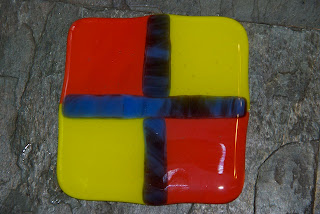I had a chance to throw a few more things in the kiln last week and learn a bit more:
|  One piece is from the last firing. Notice how dark the purple the blue became. It still looks cool, but I expected it to be a bit lighter. Also, there was a faint white-ish circle around the edge - a consequence of a too small clear glass top layer. I talked to my local guru - Susan from Glass by Susan. Following her advice, I used the grinder to take the current cloudy circle off, then used a new finer grinder bit to take away the rough marks made by the normal grinder bit. One piece is from the last firing. Notice how dark the purple the blue became. It still looks cool, but I expected it to be a bit lighter. Also, there was a faint white-ish circle around the edge - a consequence of a too small clear glass top layer. I talked to my local guru - Susan from Glass by Susan. Following her advice, I used the grinder to take the current cloudy circle off, then used a new finer grinder bit to take away the rough marks made by the normal grinder bit.
|
|  I also recently ordered some glass paints and a few decals for pendants. I created simple square, triangular, and oval patterns and chose simple colors that would serve as hopefully nice backgrounds for the details from paint and decals. To make sure I didn't run into the same ghosted edge from the clear top layer, each of the pendants have a second layer (clear on top or, for one, purple on bottom) that are about 1/4 inch larger on all sides than the main piece. |
|  Finally, I tossed in two coasters using a simple design with more transparent glass than I used on the earlier coasters. |
I'm definitely getting closer to pieces that I'm really happy with. But, I made a major error in this firing with spacing. I knew that the glass would shrink a little with firing but didn't factor in its expansion, before contraction, during the firing. So, several of my single pieces became double pieces.
|  The ghosted circle disappeared from the purple/dichroic pendant perfectly, however that pendant fused together with the square pendant to the side of it. I'll need to cut them apart, grind, and refire. (Susan's line "never refuse to re-fuse" is surprisingly catchy.) The ghosted circle disappeared from the purple/dichroic pendant perfectly, however that pendant fused together with the square pendant to the side of it. I'll need to cut them apart, grind, and refire. (Susan's line "never refuse to re-fuse" is surprisingly catchy.)
The orange and blue/purple pendants turned out pretty close to perfect, however. They're ready for my first attempts at painting and decal details. More on that in the next few weeks. |
|  I think the 1/4" border all around is a bit too large for the pendants. It looks cool when the background is a color but the light blue pendant shows how it's a bit too much, relative to what I like, when the larger piece is clear. I think the 1/4" border all around is a bit too large for the pendants. It looks cool when the background is a color but the light blue pendant shows how it's a bit too much, relative to what I like, when the larger piece is clear.
The bottom piece is a portion of a really pretty square fired by one of Susan's friends. The dichroic clear fused with blue was so pretty that I wanted to own it, before I even owned a kiln and before I had any idea what I could do with it. On the last fire, all of the iridized detail was lost once fused with a background color. Following Susan's advice, for this firing, I stuck with clear and the iridized detail is still visible. That one will soon have a cool turtle decal, once I have a few more things ready. The decals will only work with a lower temperature (~1400 degrees) so all fusing has to be done before I try that. |
| 
Lastly, the coasters. I actually really love how the more transparent glass looks on the coasters, enough that I want to make much more. However, these too were placed too closely together, giving the expansion of the glass. On the right, bottom, there also looks too be evidence that the 1/4" glass border is larger than I want. I'll cut them apart, cut off the extra clear, grind, and try to perfect them the next time I fire up the kiln. |
All that will probably have to wait for a week or so. One of my sisters has been visiting with her children and that's kept me far too busy to play with the kiln (or, before now, to catch up on notes from the last firing). I'm headed to Jacksonville to hang out with them more tomorrow and all playing with glass will have to be put on hold for a bit.
Lessons learned:
- Don't place items too close together in the kiln!
- 1/4" border is probably a little too big for clear, but looks neat as a frame.














